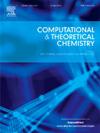蒽-查尔酮-吡啶类化合物电荷转移共晶的固态荧光调制和DFT分析
IF 3
3区 化学
Q3 CHEMISTRY, PHYSICAL
引用次数: 0
摘要
通过非共价相互作用形成的电荷转移(CT)共晶在控制其光学行为中起着关键作用。以1,2,4,5-四氰苯(TCNB)为电子受体,查尔酮(E)-3-(蒽-9-基)-1-(吡啶-3-基)pro- 2-en-1-one (A3BPO)为电子给体合成了CT共晶体。通过单晶x射线衍射(SC-XRD)结构分析表明,该共晶主要由面对面π···π相互作用引导的混合堆叠排列,辅助氢键增强了CT共晶堆叠的整体稳定性。利用粉末x射线衍射(PXRD)、红外光谱(FT-IR)、紫外可见吸收和荧光光谱等多种分析技术对结构和性能之间的关系进行了仔细研究。密度泛函理论(DFT)模拟表明,光学性质的改变主要源于受体和供体之间的CT。这些发现有助于更清楚地理解CT共晶中的堆叠模式如何影响CT与光学性质之间的相互作用。本文章由计算机程序翻译,如有差异,请以英文原文为准。

Solid-state fluorescence modulation and DFT analysis of charge-transfer cocrystal of anthracene-chalcone-pyridine compounds
Charge transfer (CT) cocrystals formed via non-covalent interactions play a pivotal role in governing their optical behaviors. A CT cocrystals were synthesized using 1,2,4,5-tetracyanobenzene (TCNB) as the electron acceptor and chalcone (E)-3-(anthracen-9-yl)-1-(pyridin-3-yl)prop-2-en-1-one (A3BPO) as the electron donor. Structural analysis through single-crystal X-ray diffraction (SC-XRD) unveiled that this cocrystal predominantly comprise a mixed stacking arrangement guided by face-to-face π···π interactions, with the overall stability of CT cocrystal stacking bolstered by auxiliary hydrogen bonds. The relationship between structure and properties was scrutinized using various analytical techniques including Powder X-ray diffraction (PXRD), FT-IR, UV–visible absorption, and fluorescence spectroscopy. Density functional theory (DFT) simulations elucidated that the modified optical properties primarily stem from CT between acceptor and donor. These findings contribute significantly to a clearer understanding of how stacking modes in CT cocrystals influence the interplay between CT and optical properties.
求助全文
通过发布文献求助,成功后即可免费获取论文全文。
去求助
来源期刊

Computational and Theoretical Chemistry
CHEMISTRY, PHYSICAL-
CiteScore
4.20
自引率
10.70%
发文量
331
审稿时长
31 days
期刊介绍:
Computational and Theoretical Chemistry publishes high quality, original reports of significance in computational and theoretical chemistry including those that deal with problems of structure, properties, energetics, weak interactions, reaction mechanisms, catalysis, and reaction rates involving atoms, molecules, clusters, surfaces, and bulk matter.
 求助内容:
求助内容: 应助结果提醒方式:
应助结果提醒方式:


